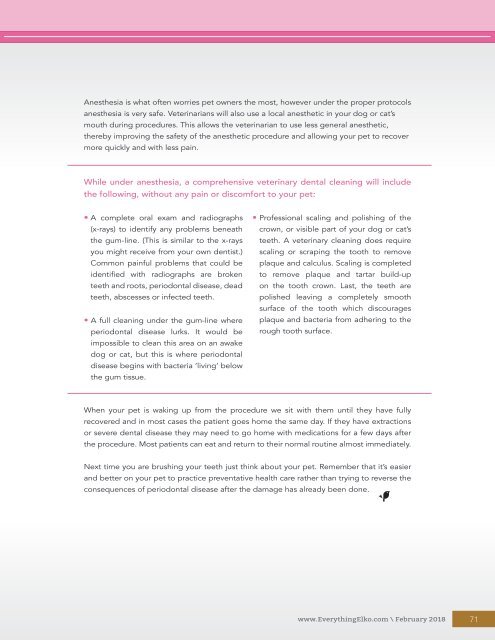EE_feb18
Create successful ePaper yourself
Turn your PDF publications into a flip-book with our unique Google optimized e-Paper software.
Anesthesia is what often worries pet owners the most, however under the proper protocols<br />
anesthesia is very safe. Veterinarians will also use a local anesthetic in your dog or cat’s<br />
mouth during procedures. This allows the veterinarian to use less general anesthetic,<br />
thereby improving the safety of the anesthetic procedure and allowing your pet to recover<br />
more quickly and with less pain.<br />
While under anesthesia, a comprehensive veterinary dental cleaning will include<br />
the following, without any pain or discomfort to your pet:<br />
• A complete oral exam and radiographs<br />
(x-rays) to identify any problems beneath<br />
the gum-line. (This is similar to the x-rays<br />
you might receive from your own dentist.)<br />
Common painful problems that could be<br />
identified with radiographs are broken<br />
teeth and roots, periodontal disease, dead<br />
teeth, abscesses or infected teeth.<br />
• A full cleaning under the gum-line where<br />
periodontal disease lurks. It would be<br />
impossible to clean this area on an awake<br />
dog or cat, but this is where periodontal<br />
disease begins with bacteria ‘living’ below<br />
the gum tissue.<br />
• Professional scaling and polishing of the<br />
crown, or visible part of your dog or cat’s<br />
teeth. A veterinary cleaning does require<br />
scaling or scraping the tooth to remove<br />
plaque and calculus. Scaling is completed<br />
to remove plaque and tartar build-up<br />
on the tooth crown. Last, the teeth are<br />
polished leaving a completely smooth<br />
surface of the tooth which discourages<br />
plaque and bacteria from adhering to the<br />
rough tooth surface.<br />
When your pet is waking up from the procedure we sit with them until they have fully<br />
recovered and in most cases the patient goes home the same day. If they have extractions<br />
or severe dental disease they may need to go home with medications for a few days after<br />
the procedure. Most patients can eat and return to their normal routine almost immediately.<br />
Next time you are brushing your teeth just think about your pet. Remember that it’s easier<br />
and better on your pet to practice preventative health care rather than trying to reverse the<br />
consequences of periodontal disease after the damage has already been done.<br />
www.EverythingElko.com \ February 2018<br />
71
















